Water From Air: A Pipe Dream Or New Frontier?
By Mary Conley Eggert And Graham Symmonds
Atmospheric water generation could be a solution to water woes confronting citizens and industry across the globe, including the U.S.
Make no mistake about it — We are facing a global water crisis. Increasing water volatility and drought, emerging contaminants, plastic pollution, and crumbling infrastructure all play a part.
In the U.S., the integrity of water supply infrastructure is in rapid decline. In its 2.2 million miles of water mains,1 the U.S. experiences over 240,000 main breaks a year, with the resultant loss of 1.7 trillion gallons of water,2 the U.S. EPA reports. That is the equivalent of every mile suffering a break every five years, and in the final analysis, one out of every seven gallons of water is lost before the drinking water reaches a customer.
It’s also worth noting that we are not addressing this problem: Los Angeles and Philadelphia, for example, have a 300-year replacement cycle. Washington, D.C. has a 200-year cycle.
News of emerging contaminants has placed doubts in the minds of consumers, driving bottled water purchases to $31 billion in the U.S., according to Consumer Reports. In neighboring Mexico, bottled water accounts for 70 percent of drinking water needs, say sources at Bluefield Research.
A frequently referenced report by the World Bank and McKinsey suggests the world is facing a 40 percent gap between the supply and demand of water.3 This gap is the result of a growing population, increasing demand, decreasing source water quality, and the readily available volume of freshwater on the planet.
But what if we have the math wrong? What if we aren’t considering other sources of water? While we have seen dramatic increases in water reuse and direct-to-potable reuse, those solutions are still relying on the same source. There are, however, significant resources that we have yet to tap. Many of these alternative resources (brackish water, ice caps, ground ice and permafrost, swamp water) can be difficult to convert to potable supplies and are often geographically isolated from population centers. Recent technology advances, however, have now opened up a relatively untapped water resource: water that can be harvested from the air. Atmospheric water represents a virtually endless supply that is universally available and continually replenished. In addition, the process of converting vapor to liquid water ensures its purity, alleviating concerns about lead, per- and polyfluoroalkyl substances (PFAS), arsenic, and other emerging contaminants.
A Natural, Renewable Resource
Analysis by the U.S. Geological Survey demonstrates that there is more water in the air than in all the rivers in the world: 3,000 cubic miles of water, or six times that flowing in our rivers today.4 Further, Atmoswater Research, publisher of the Water-From-Air Quick Guide, noted that the volume of water in the atmosphere is so large that all 7 billion people on the planet could each use 50 liters a day and consume just 0.002 percent of atmospheric water.5
Roland Wahlgren, founder of Atmoswater Research, has been studying water from air since 1984 and sees atmospheric water generation as one of the means by which we will address the global water crisis. In one analysis, Atmoswater Research investigated the potential for atmospheric water generation in 23 cities with an urgent need to solve water scarcity problems.
Wahlgren concluded that “deployment of water-from-air systems [would] likely be practical in 19 of these cities.”
As with all supply-side augmentation efforts, a fundamental component is ensuring that the integrity of the water distribution system “be coordinated with demand-side solutions like improvements in water distribution efficiency, reductions or elimination of mismanagement of surface water and groundwater, and increased water conservation actions by all sectors of society.”6
Scaling Water From Air
To date, the deployment of water-from-air technology has been geographically limited to the tropics, where relative humidity levels are high and water can be condensed in much the same way that it is captured through a dehumidifier or air conditioner.
Thirty case studies on the Atmoswater Research site7 detail applications around the globe, producing water where none previously existed and augmenting supplies when regions faced contaminants, lacked infrastructure, or simply wanted extra pure water to brew beer.
Solutions like Watergen’s water-producing truck (Figure 1) reduce the need for environmentally and financially costly tanked or bottled water shipments.
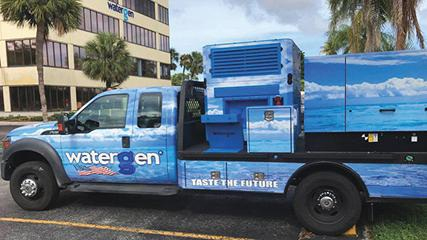
Figure 1. The Israeli company Watergen’s emergency response vehicles provided water for residents and first responders after the 2018 California forest fires.
Another company, Generation Water, offers a turnkey solution to address the need for water quality and quantity. JW Marriott’s Phuket (Thailand) Resort and Spa (Figure 2) distributes the atmospheric, mineralized water in glass bottles to 445 guest rooms as well as corporate meetings, events, and the Mandara Spa daily.
Both of the above systems are based on condensate technology, which works in humid regions of the world but is not as productive beyond the tropics or indoors. An innovation by researchers at the University of California, Berkeley is changing the air-water generation paradigm by enabling pure water to be captured from the air inside a building and even in the desert — at an energy cost of 0.5 to 0.8 kWh/liter.
Beyond Condensate
Dr. Omar M. Yaghi, professor of chemistry and codirector of the Kavli Energy NanoScience Institute at UC Berkeley, has been focused on the atmospheric water opportunity for more than two decades. Aware of the sizable volume of water available in the atmosphere, Yaghi believes harvesting this water could help turn dry deserts into oases.
Yaghi is renowned for having pioneered reticular chemistry, a new field of chemistry that is concerned with stitching molecular building blocks together to make metal-organic frameworks (MOFs). MOFs are a class of materials that combine metal ions and organic molecules to create highly porous structures that are an ideal material for capturing specific molecules from gases. MOFs have been deployed in other industries — e.g., carbon dioxide capture from flue gases, as catalysts in chemical reactions, or to separate petrochemicals in processing plants — but are only now, through Yaghi’s efforts, being applied to water generation.
Using a specific formulation of MOF, Yaghi has demonstrated the ability to generate water from air even in the driest conditions, as evidenced by tests conducted in the Mojave Desert (Figures 3 and 4).8
During field tests in California’s arid Mojave Desert, the harvester reliably produced 0.7 liters per kilogram of MOF per day — nearly three cups of water — over three days. Most significantly, the operation of the harvester is driven solely by solar power and a battery.
Since the original tests, the MOF capacity has been improved to produce 10 liters of water per kilogram.
The characteristics of MOF technology enable rapid adsorption and desorption cycles while minimizing energy use to create water.
Water Harvesting Inc. was incorporated in 2018 to take the MOF-based water-from-air technology to market. The company negotiated an exclusive commercial rights agreement with UC Berkeley. It plans to address the demand for potable water through distributed water systems ranging in size from one gallon to 5,000 gallons in production per day. Water Harvesting secured the judges’ vote for the most promising technology at the 2019 Water Environment Federation Technical Exhibition and Conference (WEFTEC). To date, the engineering testbed system has run more than 6,000 cycles with no performance degradation of the MOF.
“We are optimistic about this technology as it suggests we may be able to deliver water where no water exists at all and at a lower cost than bottled water,” said Paul O’Callaghan, CEO of BlueTech Research, a global provider of water technology market intelligence and sponsor of the Innovation Pavilion at WEFTEC.
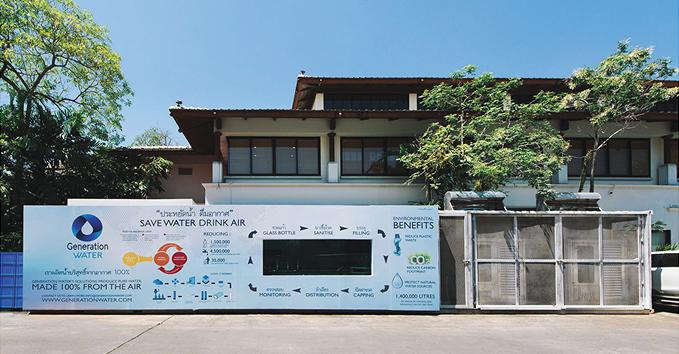
Figure 2. In a collaboration with JW Marriott’s operational, marketing, and engineering staff, Generation Water designed a turnkey solution. The solution produces up to 75,000 liters of premium mineralized drinking water per month into customized 500-ml bottles.
BlueTech Research has recently released its Horizon Scan: Atmospheric Water Capture, an in-depth study of the science, benefits, and participants in the atmospheric water capture arena. The report notes “strong potential for growth for providing drinking water in emergency response situations, rural communities, and for residential use.”10
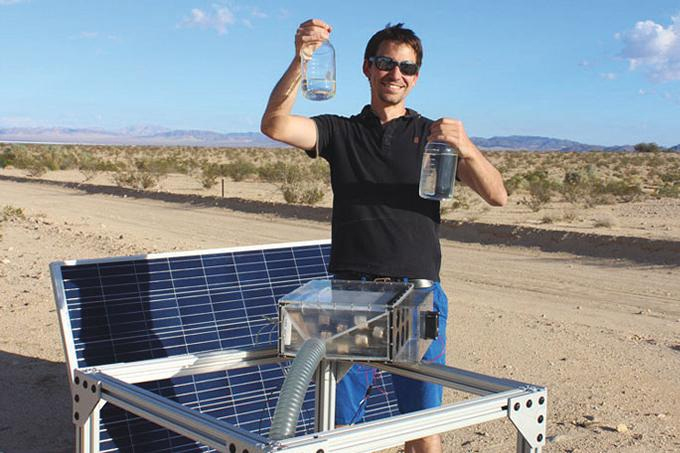
Figure 3. UC Berkeley postdoctoral fellow Matthieu Prévot displays water collected by the harvester (foreground) in the Mojave Desert. (Credit: Grant Glover/University of South Alabama)
Pure Water At The Point Of Use
A significant advantage of taking water from the atmosphere is that it can provide pure water at the point of use, bypassing the supply and infrastructure issues facing our cities. For utilities that are serving less than 100 percent of the population in their service region, Wahlgren sees an opportunity to achieve 100 percent service by offering the distributed water systems in places where adding piped infrastructure would be uneconomical or where the existing piped distribution system is seriously deteriorated or contaminated. The need for drinking water continues during service interruptions and emergencies, so water-from-air solutions provide resilience to citizens and cities weathering extreme weather events and emerging contaminants.
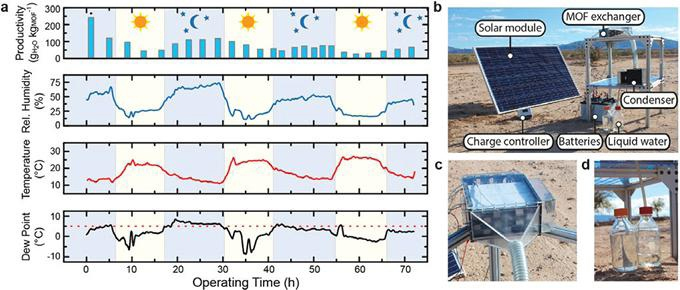
Figure 4. Practical atmospheric water harvesting in the Mojave Desert. (a) Diagram displaying the water harvesting productivity after each water harvesting cycle (WHC), the ambient relative humidity and temperature, and the corresponding dew point. The productivity of the first WHC is higher because the experiment started with a fully saturated MOF bed. All data was measured over the course of three continuous days of operation in the Mojave Desert. The dotted, red line indicates the 5°C dew point, representing the lower limit for the operating range of direct condensation technologies; (b) Photograph of the water harvester with labeled parts; (c) Close-up view of the MOF exchanger; (d) Water collected under continuous operation.⁹
Following the distributed system model created for onsite water reuse (Figure 5)11, water from air offers a means to deliver pure drinking water off-grid, eliminating the transportation cost and plastic pollution associated with bottled or tanked water. This is perhaps the reason the U.S. Army recently announced plans to invest in this new frontier. A Broad Agency Announcement cited the value of water from air as a strategic defense mechanism, freeing troops from having to rendezvous for water deliveries. Similarly, off-grid populations like the Navajo Nation may soon be tapping water directly from the air, speeding access to drinking water where wells have dried up or have been contaminated. The financial and environmental savings are reasons to consider adding water from air to any location where trucking or bottled water has become the default water resource.
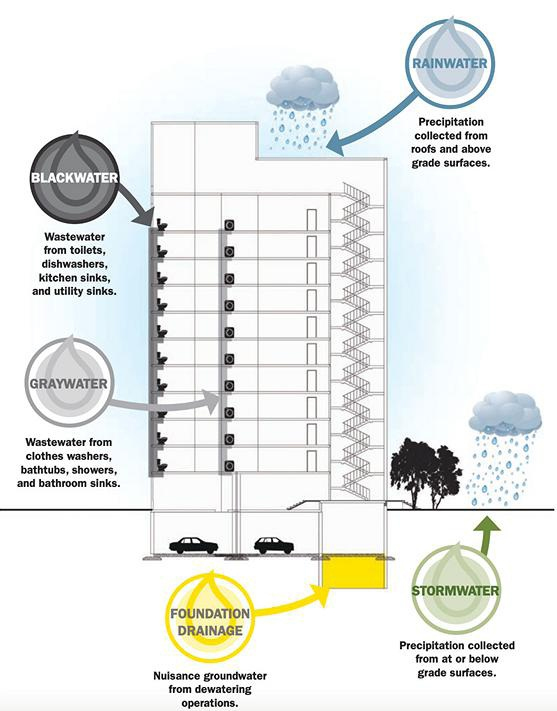
Figure 5. A water-from-air system on top of a building or in the boiler room of a building could complement the existing stormwater, gray, and blackwater systems described in the Non-potable Water Systems Guidebook, published by the San Francisco Public Utilities Commission
Rethinking Water Services
Air-derived water provides an opportunity to rethink water services. Before constructing substantial civil works to meet the needs of a community, water providers might consider water from air to deliver safe drinking water to the point of need. ASSE International and IAPMO (The International Association of Plumbing and Mechanical Officials) are in the process of creating a performance and efficiency standard for products that deliver water “using air as a source.” Standards legitimize an industry and should also make it easier for regulators and government officials to assess solution providers.
Using the services model, water from air delivers on the core pillars of water:
• Security — augmenting existing water sources with a potable water source to address the volatility of the water cycle, including short- and long-term drought response, flooding, and contaminants.
• Availability — providing a redundant source of drinking water capable of delivering water 24/7 where no energy or infrastructure exists.
• Affordability — For less than the cost of bottled water or the cost of a lead-lateral replacement program, consumers can access safe, reliable drinking water.
• Sustainability — Atmospheric water is regenerated through nature’s evaporation process, ensuring a continually renewable supply.
Water industry investor and serial entrepreneur, Mike Reardon, former chief executive of Culligan Water, is enthusiastic about the prospects for this new technology. He believes it presents an “exciting new frontier that could dramatically change the approach to solving the world’s water problems with, in effect, a fresh ‘source’ of water.” He compared the potential of renewable clean water from air to the promise of unlimited, renewable electricity from solar cells. “While the rest of the world works with conventional technologies on treatment and conveyance of the existing water supply to where it is most needed, atmospheric water offers a virtually unlimited new resource through the conversion of air into good clean water.”
References:
- U.S.EPA: “Drinking Water Infrastructure Needs Survey and Assessment: Sixth Report to Congress,” https://www.epa.gov/sites/production/files/2018-10/documents/corrected_sixth_drinking_water_infrastructure_needs_survey_and_assessment.pdf, p.23.
- U.S.EPA: “Addressing the Challenge Through INNOVATION,” Office of Research and Development National Risk Management Research Laboratory.
- McKinsey: "Charting our Water Future", https://www.mckinsey.com/~/media/mckinsey/dotcom/client_service/sustainability/pdfs/
charting%20our%20water%20future/charting_our_water_future_full_report_.ash - U.S.Geological Survey: “Where is Earth’s Water?” https://www.usgs.gov/special-topic/water-science-school/science/where-earths-water?qt-science_center_objects=0#qt-science_center_objects
- Wahlgren, R., “Water-From-Air Quick Guide,” CreateSpace Independent Publishing Platform; 2nd edition, 2016.
- Ibid.
- Atmoswater Research, Case Studies About Water-from-Air, https://www.Atmoswater.com/case-studies-about-water-from-air.html
- University of California Berkeley: “Water Harvesting Makes It Easy to Drink Water From Thin Air,” https://www.universityofcalifornia.edu/news/water-harvester-makes-it-easy-drink-water-thin-air
- Rapid Cycling and Exceptional Yield in a Metal-Organic Framework Water Harvester, Nikita Hanikel, Mathieu S.Prévot, Farhad Fathieh, Eugene A.Kapustin, Hao Lyu, Haoze Wang, Nicolas J.Diercks, T.Grant Glover, and Omar M.Yaghi, ACS Central Science 2019 5 (10), 1699-1706, DOI: 10.1021/ acscentsci.9b00745, https://pubs.acs.org/doi/abs/10.1021/acscentsci.9b00745
- “Horizon Scan: Atmospheric Water Capture,” BlueTech Research, October 2019, http://www.bluetechresearch.com
- San Francisco Public Utilities Commission: https://sfwater.org/Modules/ShowDocument.aspx?documentID=11629
About The Authors
 Mary Conley Eggert is chief innovation officer at GlobalWaterWorks, a 501c6 and marketing consultancy committed to advancing business adoption of smart water technologies to ensure the availability of clean, fresh water for future generations. She has a bachelor’s degree from the University of Wisconsin–Madison and an MBA from Northwestern University’s Kellogg School of Management.
Mary Conley Eggert is chief innovation officer at GlobalWaterWorks, a 501c6 and marketing consultancy committed to advancing business adoption of smart water technologies to ensure the availability of clean, fresh water for future generations. She has a bachelor’s degree from the University of Wisconsin–Madison and an MBA from Northwestern University’s Kellogg School of Management.
 Graham Symmonds is a water industry expert at GlobalWaterWorks, providing his deep industry knowledge, expert analysis, and market insight to help companies commercialize their solutions. A prolific writer and speaker, he has held a variety of executive-level roles with utilities and water technology innovators. Prior to joining GWW, Symmonds was utility manager for Algonquin Water Resources of America, responsible for all business, technical, and regulatory operations.
Graham Symmonds is a water industry expert at GlobalWaterWorks, providing his deep industry knowledge, expert analysis, and market insight to help companies commercialize their solutions. A prolific writer and speaker, he has held a variety of executive-level roles with utilities and water technology innovators. Prior to joining GWW, Symmonds was utility manager for Algonquin Water Resources of America, responsible for all business, technical, and regulatory operations.
